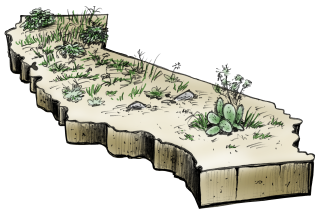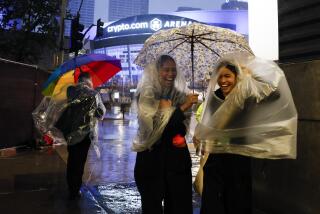Newsletter: Water and Power: The anonymous water blogger
- Share via
Your guide to the California drought from the Los Angeles Times.
NEWS AND POLICY
Water savings: Despite slowing conservation during winter months, California is still on track to meet Gov. Jerry Brown’s mandate to cut water use by 25%. California cut its water usage by 20.3% in November, the lowest in six months of reporting and moved California’s cumulative savings to 26.3% from 27.1% in October.
Entertaining read: California water policy can be an insular, jargon-ridden field. On most issues, the arguments and counter-arguments have been around so long that they can seem about as flexible as a concrete dam. But Vlad the Impaler is trying to make it interesting.
Are we done yet?: How will we know when the drought is finally over? That could be difficult to assess.
Stormwater runoff: The key to water conservation in the future might come down to capturing rainwater instead of wasting it.
ON THE GROUND
Danger ahead: Silverado Canyon feels Mother Nature’s force — both in brush fires and the mudslides that often follow them. In 1969, five people were killed and 17 injured in a mudslide. In 2005, another mudslide killed a young girl. Now, El Niño has residents again on edge.
Rising waters: Perhaps the biggest beneficiary of El Niño might end up being Lake Folsom, which until recently was ravaged by the drought.
Ski season: Suddenly, California is once again a hot ski destination.
BIG IDEAS
“There is a good chance that if everything goes right over the next four months, we could end up with good reservoir recovery. We need much better than average snowpack this year for complete reservoir recovery, and so far we are encouraged.”
– Frank Gehrke, who oversees snow surveys for California’s Department of Water Resources
“This is not a bashful El Niño. This is a brash El Niño.”
– Bill Patzert, climatologist with the NASA Jet Propulsion Laboratory in La Cañada Flintridge
TIPS
El Niño threatens to bring flash flooding. Some sobering points:
— Flash floods can turn a calm landscape into a raging river in a matter of minutes.
— Most flash floods are caused by slow-moving thunderstorms, hurricanes or tropical storms, but also by dam or levee failures.
Please let us know what we can do to make this newsletter more useful to you. Send comments, complaints and ideas to Alice Walton or Shelby Grad.
More to Read
Sign up for Essential California
The most important California stories and recommendations in your inbox every morning.
You may occasionally receive promotional content from the Los Angeles Times.











